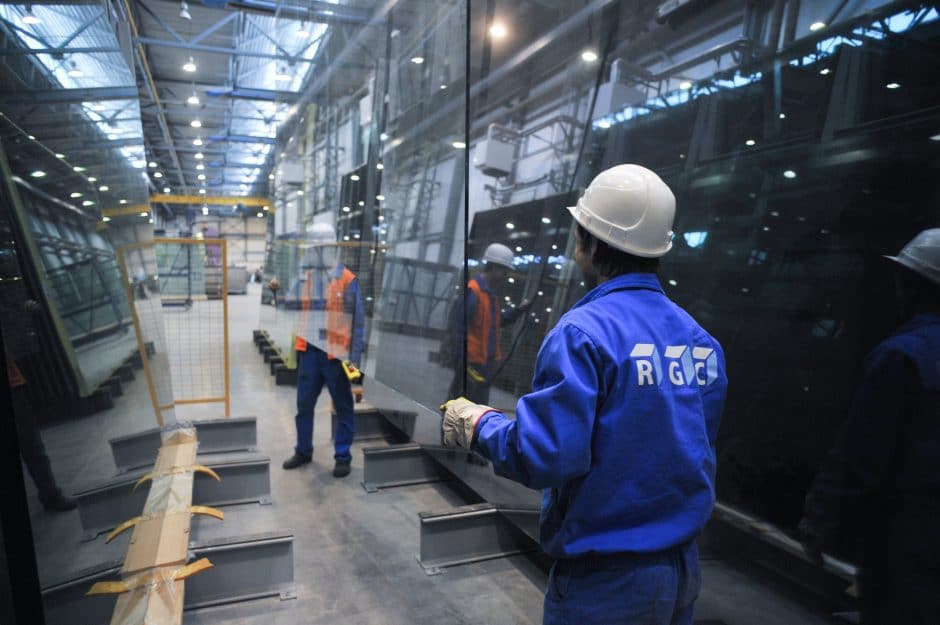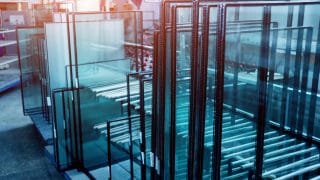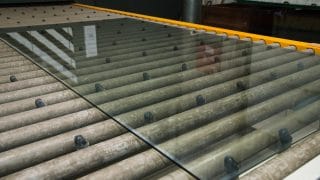
The majority of glass products used in the building industry are made from float glass. This type of glass uses a special, highly-regulated process to develop the durable, crystal-clear sheets we’re used to seeing in our windows, shower doors, and even automobiles.
What is float glass?
Float glass is a type of glass product made by floating molten glass over a bed of molten tin. It requires the use of heavy-duty factory machinery, strict formulas of raw materials, and very tight tolerances. The credit for the invention of float glass goes to Sir Alastair Pilkington as he was looking for a more efficient way to generate flat glass sheets.
Before the float glass process, manufacturers typically made drawn glass or plate glass. Drawn glass involves pulling molten glass vertically through a die, while plate glass involves labor-intensive grinding and polishing.
Note: The reason tin is the metal of choice is it is the only metal that remains stable as a liquid at tempertures high enough for this process (600 degress Celcius).
How is float glass made?
Float glass is made in factories using very high temperatures to heat glass to its liquid form, which is then floated over molten tin.
1. Mixing the raw materials
The process of making float glass involves heating raw materials until they become molten glass. In their raw form, the mixture of materials is known as “the batch.”
The majority of float glass batch is made from silica, or sand, which is one of the most abundant resources on the planet. In addition, manufacturers add limestone to make the glass flow better, dolomite to improve strength and scratch resistance, and soda ash to lower the melting point of the sand. Also, recycled glass known as cullet is also mixed back into the formula.
2. Making the glass
With the formula dialed in, the ingredients pass through a furnace that reaches up to 2900 degrees Fahrenheit. After several hours, the mix becomes molten. The next step in the process is allowing the molten glass to flow onto a bed of very dense molten tin, allowing the glass to take the shape of the container (in this case, the “canal”). Here, machinery within the canal pulls the glass ribbon along, adjusting the speed to obtain the ideal thickness.
3. Polishing
It’s at this point flames polish the “air side” or “score side” of the sheet of glass. The air side is the top of the glass, while the tin side lays on top of the molten tin. This process creates strong glass that is primarily blemish-free.
4. Cooling
After the polishing process, the ribbon is then moved to another chamber known as the lehr. The lehr slowly cools the sheet of glass, preventing any air bubbles, internal stresses, or imperfections from occurring. This process is called “annealing.”
5. Cutting
Once cool, sheets of glass are cut from the continuous ribbon by machine (or manual process). Imperfect sheets mix back in as cullet, as do any scoring marks from the manufacturing process. The sheets are then stacked and packaged before shipping.
The majority of glass products used in the building industry are made from float glass. This type of glass uses a special, highly-regulated process to develop the durable, crystal-clear sheets we’re used to seeing in our windows, shower doors, and even automobiles.
What is float glass?
Float glass is a type of glass product made by floating molten glass over a bed of molten tin. It requires the use of heavy-duty factory machinery, strict formulas of raw materials, and very tight tolerances. The credit for the invention of float glass goes to Sir Alastair Pilkington as he was looking for a more efficient way to generate flat glass sheets.
Before the float glass process, manufacturers typically made drawn glass or plate glass. Drawn glass involves pulling molten glass vertically through a die, while plate glass involves labor-intensive grinding and polishing.
Note: The reason tin is the metal of choice is it is the only metal that remains stable as a liquid at tempertures high enough for this process (600 degress Celcius).
How is float glass made?
Float glass is made in factories using very high temperatures to heat glass to its liquid form, which is then floated over molten tin.
1. Mixing the raw materials
The process of making float glass involves heating raw materials until they become molten glass. In their raw form, the mixture of materials is known as “the batch.”
The majority of float glass batch is made from silica, or sand, which is one of the most abundant resources on the planet. In addition, manufacturers add limestone to make the glass flow better, dolomite to improve strength and scratch resistance, and soda ash to lower the melting point of the sand. Also, recycled glass known as cullet is also mixed back into the formula.
2. Making the glass
With the formula dialed in, the ingredients pass through a furnace that reaches up to 2900 degrees Fahrenheit. After several hours, the mix becomes molten. The next step in the process is allowing the molten glass to flow onto a bed of very dense molten tin, allowing the glass to take the shape of the container (in this case, the “canal”). Here, machinery within the canal pulls the glass ribbon along, adjusting the speed to obtain the ideal thickness.
3. Polishing
It’s at this point flames polish the “air side” or “score side” of the sheet of glass. The air side is the top of the glass, while the tin side lays on top of the molten tin. This process creates strong glass that is primarily blemish-free.
4. Cooling
After the polishing process, the ribbon is then moved to another chamber known as the lehr. The lehr slowly cools the sheet of glass, preventing any air bubbles, internal stresses, or imperfections from occurring. This process is called “annealing.”
5. Cutting
Once cool, sheets of glass are cut from the continuous ribbon by machine (or manual process). Imperfect sheets mix back in as cullet, as do any scoring marks from the manufacturing process. The sheets are then stacked and packaged before shipping.
6. Tinting and Tempering
Mixing additional materials into the batch allows the glass manufacturer to create tinted glass. This glass type will allow less visible light through the glass pane, and will also give the window a bit of a different hue. A low-E coating can also provide some tint and block some light from passing through.
Also, the floating process gives manufacturers the base material (float glass) used to create tempered glass, laminated safety glass, or toughened glass.
Advantages of float glass
Float glass is one for the most common and popular types of glass for a reason: it looks great, is very strong, and is more efficient to make.
- Smooth. Over materials like drawn glass, float glass plates are much smoother, with uniform and parallel surfaces. This creates better clarity and fewer blemishes, making it much more suitable for use in windows and doors.
- Strong and durable. The process of creating and cooling float glass makes it stronger and more durable than drawn glass. Even when comparing a sheet of float glass to a sheet or plate glass of the same thickness, the float glass is significantly stronger. By allowing the molten glass to flow and then cool slowly, the float glass process minimizes imperfections or internal stresses, making the material much more durable than those made by other processes.
- Versatile. Float glass is also versatile, which is one of its biggest advantages. By tweaking the batch ingredients, manufacturers can create tinted glass that allows less light through the sheet. Also, float glass sheets can be shaped and contoured for a variety of applications.
- Efficient. The process of making float glass is generally more efficient than the process of making plate glass. The processing equipment through which the batch and glass ribbon pass through are highly regulated to maintain specific temperatures, allowing them to run more efficiently. Also, considering that much of the batch comes from cullet, nothing goes to waste during the float glass process.
Disadvantages of Float Glass
Float glass isn’t perfect and it does have some disadvantages.
- Breaks in large pieces. Float glass that hasn’t been through the tempering process can break into large shards, becoming potentially dangerous. The tempering and toughening process can help, making float glass suitable for window glass in high-rises and high-wind situations. But, without this process, it can be largely unsafe.
Complicated manufacturing process. While it’s more economical to make float glass than plate glass over time, the equipment required to create float glass is very expensive. Additionally, float glass that hasn’t been properly cooled can be brittle or break due to the thermal stresses experienced during manufacturing. For this reason, the entire manufacturing process requires special attention.
MT Copeland offers video-based online classes that give you a foundation in construction fundamentals with real-world applications.
Classes include professionally produced videos taught by practicing craftspeople, and supplementary downloads like quizzes, blueprints, and other materials to help you master the skills.



